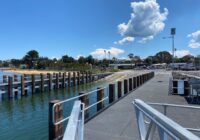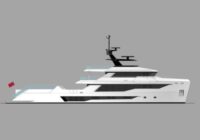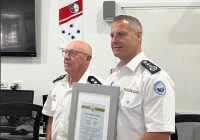History belongs to all of us. Sometimes, you’re entrusted with a piece of it. The new owner of the 1920 ketch TALISMAN valued the yacht’s historic significance. But he couldn’t help but wonder how its original designer, Henry Rasmussen, would improve his classic design with access to today’s technology. Could he restore the TALISMAN and its systems for another 100 years of bringing joy to those who stepped on board? Could he do it while maintaining its elegance and eco-friendliness?
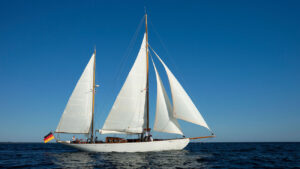
The TALISMAN, when new, was strictly wind-powered. The 75-footer was the first steel-hulled yacht built at Rasmussen’s shipyard and she sailed under several names, with different owners, for 99 years. She survived a fire and a lightning strike, but damage went unrepaired and time had taken its toll. In 2019, an ambitious crew sailed the battered yacht to HCC Badeverft, a preferred Torqeedo refit partner, in Denmark. The owner’s brief: history meets technology. The team at HCC was ready to take on the challenge. It would require a complete restoration.
“Torqeedo’s preferred refit partners are shipyards with specialised knowledge and training in Deep Blue’s integrated electric propulsion and energy management systems,” said Matthias Schubert, director project sales for Torqeedo GmbH. “They’re the best place to start your electrification journey.”
Another expert in electric propulsion, Hauschildt Marine, was brought in to define the TALISMAN’s high-tech drivetrain. The most important key data was quickly established: Torqeedo’s Deep Blue 100 kW electric drive system would replace the diesel engine. A 25 kW electric bow thruster would be added for manoeuvrability. Both would be powered by a Deep Blue lithium-ion battery bank charged with renewable energy from onboard solar panels and by using the electric drive as a hydrogenerator when the yacht was under sail.
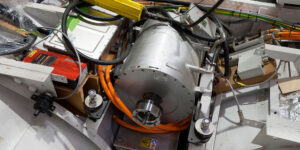
The Torqeedo drive system at installation. Credit Stefan Schorr
“I would like to make my small contribution to more sustainability and show what is possible,” said the TALISMAN’s owner. He sees the refurbishment of his classic yacht from 1920 as a lighthouse project, similar to the new construction of the Spirit 111, where “environmental friendliness played a major role.”
But the owner’s vision for TALISMAN went beyond a sustainably propelled yacht that generates its own energy. All materials and systems were evaluated to ensure a low environmental impact. Everything that was removed from the yacht during the restoration was closely evaluated, catalogued, cleaned and repaired. Anything that couldn’t be reused was recycled, or “upcycled”. Even the old sails were transformed into unique and beautiful bags for the owner’s onboard guests.
Since TALISMAN is classified by the international classification society DNV, a hybrid drivetrain was required. The battery bank’s capacity of about 120 kWh allows for pure motor cruising up to 189 nautical miles (in calm weather, at an average speed of six knots). If extended motoring is required, a backup diesel generator is integrated into the Deep Blue system. It is positioned in the forecastle and is managed completely by the central system.
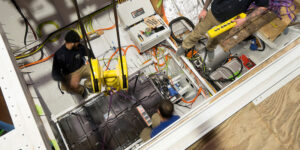
Installation of the Torqeedo 40 kWh Deep Blue batteries. Credit Stefan Schorr
Thanks to the integrated energy management of Torqeedo’s Deep Blue Hybrid, the yacht is almost exclusively powered by the renewable energy generated by sun and wind. This power can be used wherever it is needed: for propulsion, for the 24 V onboard power supply or for operating devices with 230 V alternating current. Cooking is done on an induction stove and electric underfloor heating warms this classic beauty. Thus, the TALISMAN completely dispenses with the use of gas and gasoline. Even the outboard motor for the dinghy is an electric one from Torqeedo.
The sails and ropes are sustainably produced from 100% recycled PET bottles. The teak and mahogany that could not be salvaged come from certified plantation cultivation: every single plank processed in the shipyard is numbered and its origin can be traced. “This seems to me to be a reasonable compromise for the desired result, knowing that local woods would be even more sustainable,” says the owner.
“The Talisman refit has been a great journey in sustainability. As a shipyard, it has been an honour to have a customer that values our planet this highly. It is a good feeling to look at the project in the end and know that we did everything we could to be environmentally friendly,” said Ole Jonge of HCC Bådeværft.
The Abeking & Rasmussen (A&R) shipyard, where TALISMAN was originally constructed, is also taking steps toward sustainable shipbuilding. Today, its yachts are equipped with efficient energy systems and heat recovery systems, and zinc anodes are being replaced by active anodes that do not pollute the oceans.
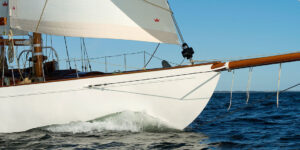
The sails and ropes are sustainably produced from 100% recycled PET bottles. Credit Stefan Schorr
“By the end of 2022, a first sustainability report will be available under the title ‘Sustainability@ A&R,'” explains project manager Jens Bottke. “Probably the most beautiful form of sustainability, however, is to see that the TALISMAN, built at A&R over 100 years ago, is still in use and shining in such splendor.”





